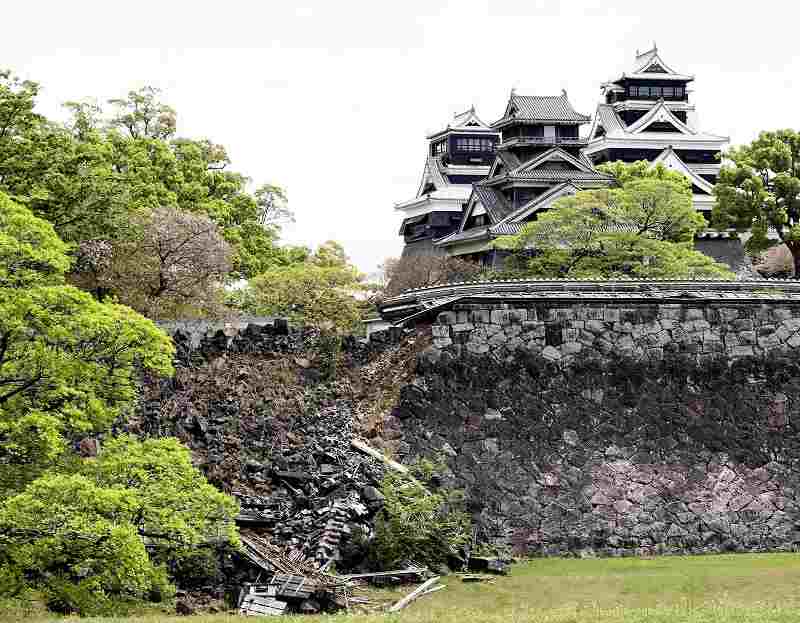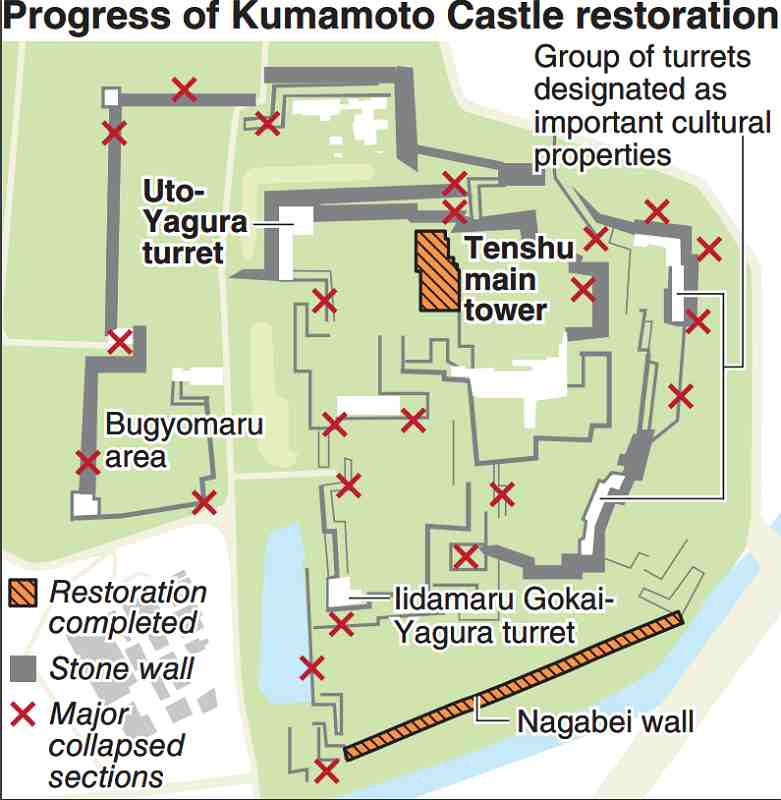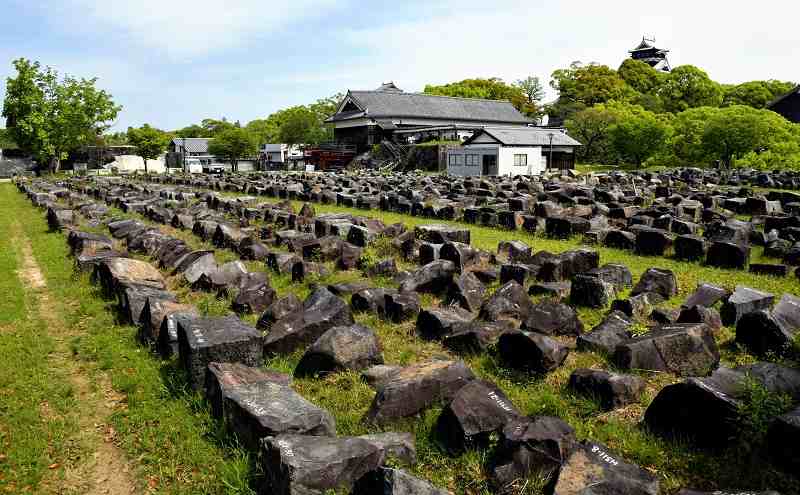
A collapsed portion of stone wall, which is not a designated cultural property, lies as it has since the day of the Kumamoto Earthquake five years ago, in the shadow of the restored Tenshu main tower and Uto-Yagura turret.
13:40 JST, May 13, 2021

KUMAMOTO — Restoration work continues to forge ahead on Kumamoto Castle, which was severely damaged by a pair of powerful earthquakes that hit the southern city over three days in April 2016. With the recent completion of the Tenshu main tower, the task now turns to collapsed stone walls, damaged turrets and other structures this spring, which marks the fifth anniversary of the disaster.
The turrets are among many designated important cultural properties on the site. Unlike the Tenshu tower, which is made of reinforced concrete and is a reproduction of the original, the structures were built centuries ago using traditional techniques.
The challenge at hand now is to strike a balance between the traditional and the modern, between preserving authenticity and using modern methods to assure resistance to the next big one.
Collapsed walls left as is
In the section known as Bugyomaru located southwest of the castle, large stones from collapsed portions of the castle walls are lined up in rows. The larger ones are more than a meter across. About 7,500 of these stone were collected from various places on the castle grounds after the quake.
Nearby, the remains of a collapsed wall, which is not a designated cultural property, remain as is. The scene is a stark contrast to the main tower — which had the highest priority as a symbol of the restoration — looming above.
Kumamoto Castle, built by the warlord Kato Kiyomasa (1562-1611), is known for its high, sloping stone walls called Musha-gaeshi (“warrior repellers”), which are elegantly curved at the base before gradually growing steep to keep even the most agile of enemies from climbing. The castle site, including the stone walls, is a designated special historical site, in essence making it a “national treasure landmark.”
The earthquakes damaged about 23,600 square meters of stone walls, or about 30% of the total, but in the five years since, only a portion has been restored, including 740 square meters at the base of the castle tower.
One big reason for the slow pace is that a lot of time was needed looking into construction methods. In principle, the stone walls need to be restored to their pre-earthquake state using traditional techniques. Not only must the collapsed stones be returned to their original places, but areas where bulging has occurred need to be reinforced or restacked. In doing so, it is necessary to devise ways to keep from causing damage above the walls, such as to foundation stones of structures.
In addition, safety measures must be taken to prepare for major earthquakes of the future.
The reason the stone walls collapsed, it was deduced, was from a subsiding of the inner layers of round stones, called “guri-ishi.” Inserting reinforcement sheets to suppress the stones’ movement will enhance earthquake resistance, but there are limits.
“Restoration work using such modern methods can only be done in exceptional cases, as it can affect the castle’s value as a cultural property,” said Tatsuo Amita, director of the Kumamoto municipal government’s Kumamoto Castle general office. “When adopting these methods, it is necessary to clearly state the rationale and extent of the work at each location.”
The reinforcement sheets were used in some places when the walls of the castle’s main tower were restored. This was done in consideration of the fact that when the replica tower was built in 1960, alterations were made in the stone walls, and that many people pass through the area.
The sheets will be limited in restoring the stone wall of the Iidamaru Gokai-Yagura (five-storied) turret. An excavation survey found that different portions of the structure had undergone repairs during the Edo period (1603-1867), Meiji era (1868-1912) and Heisei era (1989-2019), making things complicated. It is expected that sheets will only be used in sections repaired since the Meiji era.
There is also a method of compressing mounds of soil in front of the stone walls to keep them from collapsing. As this avoids physical contact with the walls, it has the advantage of not marring the value as a cultural property, and is being considered for the high walls of the Uto-Yagura turret, an important cultural property, which was found to have bulges.
But there is a downside, according to Prof. Yoshihiro Senda at Nara University, a specialist of castle archaeology who served on an expert committee for the castle’s restoration.
“The Uto-Yagura stone wall is of the highest quality in terms of craftsmanship and beauty,” Senda said. “The method of creating a mound will result in hiding a portion of a stone wall that has intrinsic value as a special historical site.”

Rows of stones from collapsed walls are kept in the Bugyomaru area, waiting to be returned to their original places.
Preparing for the next big one
The restoration of all 13 structures designated as important cultural properties and damaged in the quakes, including two destroyed turrets in the northeast corner, is premised on the work first being completed on the stone walls.
For this reason, only work on the Nagabei wall, which suffered only minor damage, has been completed among the 13. For collapsed structures, the designation of cultural property is retained by preserving roof tiles, pillars and other materials and returning items as much as possible to their original places. The remaining turrets will be totally or partially dismantled.
“For the five-storied Uto-Yagura, it is necessary to consider using modern construction methods, such as building a foundation to support the structure, to ensure the stability of the stone wall and turret as a whole,” Senda observed.
The Kumamoto municipal government plans for the restoration work to be completed in fiscal 2037.
“Up to now, we have never had a castle suffer such wide-ranging damage,” said Toshitaka Yamao, a professor emeritus at Kumamoto University and civil engineering specialist who chaired the expert committee. “It is also the first time that stone walls were examined one by one with both on-site surveys and model-based experiments.
“It is necessary to work meticulously to be prepared for the next big earthquake, rather than just planning and meeting a construction schedule.”
Guidelines for stone walls
Taking a lesson from the damage incurred by the stone walls of Kumamoto Castle during the Kumamoto Earthquake, the Cultural Affairs Agency will begin drawing up guidelines this fiscal year for determining the earthquake resistance of castle walls.
This will include ways to detect stone walls in danger of collapsing and concrete measures to prevent damage.
The agency allocated about ¥8 million from the current fiscal budget for this purpose. A committee of experts on castles, civil engineering and related fields will be set up to keep tabs on the process of restoration work at Kumamoto Castle and to carry out surveys of the stone walls of other castles.
The guidelines will be compiled by the next fiscal year at the earliest and disseminated to local governments and others across the country.
According to the agency, there are 88 government-designated historical sites nationwide with castles and/or stone walls. Even since the Kumamoto Earthquake, however, there are still no guidelines on quake-resistance applicable to stone walls.
It is expected that the know-how gained during the process of restoring Kumamoto Castle will be useful in devising quake-resistance measures for castles and stone walls in other locations.
"Society" POPULAR ARTICLE
-

M4.9 Earthquake Hits Tokyo, Neighboring Prefectures
-

Israeli Tourists Refused Accommodation at Hotel in Japan’s Nagano Pref., Prompting Protest by Israeli Embassy and Probe by Prefecture
-

M7.5 Earthquake Hits Northern Japan; Tsunami Waves Observed in Hokkaido, Aomori and Iwate Prefectures
-

Tsukiji Market Urges Tourists to Avoid Visiting in Year-End
-

High School in Kyoto Says Students Shoplifted during Recent School Trip to Bali, Indonesia
JN ACCESS RANKING
-

Tokyo Economic Security Forum to Hold Inaugural Meeting Amid Tense Global Environment
-

Keidanren Chairman Yoshinobu Tsutsui Visits Kashiwazaki-Kariwa Nuclear Power Plant; Inspects New Emergency Safety System
-

Imports of Rare Earths from China Facing Delays, May Be Caused by Deterioration of Japan-China Relations
-

University of Tokyo Professor Discusses Japanese Economic Security in Interview Ahead of Forum
-

Japan Pulls out of Vietnam Nuclear Project, Complicating Hanoi’s Power Plans























